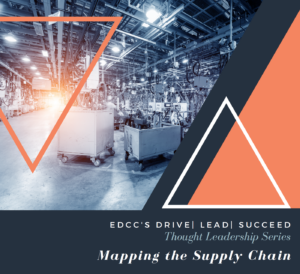Mapping the Supply Chain
Following a “Mapping the Supply Chain” event in August 2022, the Economic Development Council of Colorado (EDCC) produced a thought leadership paper expanding upon the concepts and data our team presented during the webinar.
Here is the Executive Summary from the paper, written by Manufacturer’s Edge Director of Client Services Rob Newbold:
Supply chain disruptions have been a key headline for more than two years. From electronics to automobiles, baby formula, steel, and toilet paper, we’ve experienced global shortages of the things that we use and expect every day. At a broad level, we understand there are many factors that have influenced this breakdown of a system that we assumed to be stable and precise. However, the warning signs of breakdown have been building for years. COVID’s impact has been multi-faceted in further upending a tenuous link of chains that ensure we get what we want.
These six trends have many connections to the conversations that you’ll be hearing today. We tend to look at a list like this and say, “These are issues outside of my purview and control. What can I do? ”What we fail to consider is that at the starting point, every supply chain breaks down to a simple system that manufacturers and you can influence – that is the proactive and effective management of risks and relationships.
Our goal is to provide you with trends, tools, and activities that you can use with your local manufacturers to help shrink the complexity and concerns around supply chain disruptions in your community. Supply chains will remain fluid for some time as political landscapes shift, labor shortages grow, climate change drives population upheaval and consumer preferences change. Manufacturers, distributors, and customers want more visibility and immediacy in sourcing; however, the true test of our future supply chain is in its resiliency to changing conditions. A better understanding of the resources available to support manufacturers will give us more leverage to influence those changing conditions.

